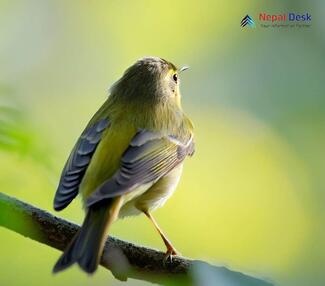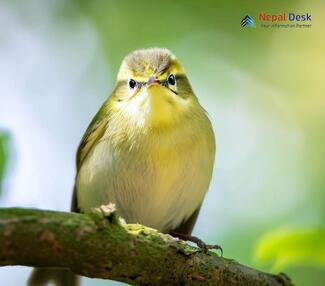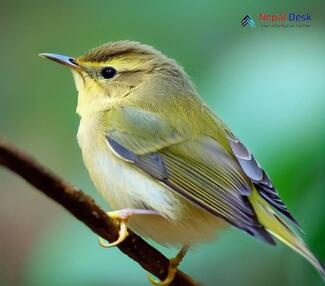Nepal's captivating natural landscapes and vibrant wildlife are a magnet for bird lovers from across the globe. Among its diverse avian inhabitants is the enchanting Greenish Warbler, a tiny songbird that enhances the beauty of Nepal with its melodious voice. This little creature was once classified as an "Old World warbler" but now belongs to the new leaf-warbler family Phylloscopidae. In this article, we'll take you through the mesmerizing world of the Greenish Warbler and shed light on where to find them in Nepal.
Getting Charmed by the Greenish Warbler
The eye-catching Greenish Warbler (Phylloscopus trochiloides) stands out with its unique plumage and soothing song. Their bodies display various shades of green, which help them blend effortlessly into Nepal's lush greenery. Though small in size (between 10 to 12 centimeters), their delightful melodies never fail to brighten their surroundings.
Nepal: A Home for Greenish Warblers
Nepal's extensive range of ecosystems, from forests and grasslands to wetlands, makes it an ideal habitat for Greenish Warblers. You can spot these adorable birds in multiple locations throughout the country – from Terai's lowlands to hilly regions and even up to heights exceeding 3,000 meters.
Greenish Warblers commonly dwell in mixed woodlands, where they flit among leaves looking for insects to munch on. If you visit during their breeding months (April through July), you might even catch them busily constructing nests hidden low to the ground or on it.
Prime Birdwatching Season
If observing Greenish Warblers in their element is on your bucket list, then plan your trip to Nepal during migration season (October-November or March-May). During these periods, many guided tours will lead you to some of Nepal's premier birdwatching locations, such as Shivapuri Nagarjun National Park, Bardia National Park, and Chitwan National Park.
Protecting Nepal's Feathered Friends
Given the alarming pace of habitat loss and climate change, preserving Nepal's rich biodiversity is crucial. The Nepalese government and local NGOs have established several conservation programs focused on safeguarding habitats critical to bird species like the Greenish Warbler. By participating in responsible tourism practices and spreading awareness about these initiatives, you can directly contribute to protecting Nepal's awe-inspiring wildlife for generations to come.
In a nutshell, the Greenish Warbler epitomizes the vivacious birdlife that inhabits Nepal's scenic landscapes. So when planning your next birdwatching adventure, keep an eye out for this delightful little songbird and appreciate its melodic tunes as a lasting reminder of your journey.
Physical Description
- Males and females have identical plumage - greenish upperparts and pale yellow underparts.
- They have a distinct supercilium (stripe above the eye) and pale yellow throat.
- Their slim pointed bill is ideal for grabbing small insects out of crevices.
Song and Calls
- The male's song is a melodic repetitive series of high-pitched whistling notes.
- Calls include a distinctive explosive "pseet" when alarmed.
- Songs establish breeding territories, while calls communicate alarm.
Breeding and Nesting
- Males display courtship feeding, offering insects to prospective mates.
- The female builds a neatly woven cup nest low in dense shrubs or ferns, well-hidden.
- She lays 3-6 creamy white eggs with brown speckles, incubated for 10-13 days.
Behavior
- Constantly on the move, flitting through branches picking off tiny prey.
- Will join mixed foraging flocks with other warbler species in non-breeding months.
- Become more timid in winter, staying hidden in dense understory vegetation.
Migration
- Nepalese populations migrate in winter to Southeast Asia, some as far as Indonesia.
- Return migration starts in late February through early April.
- Show remarkable navigation - some return to the same nesting sites annually.
Diet
- Feeds mainly on small spiders and insects like moths, aphids, and beetles which it gleans from leaves and branches.
- Will occasionally eat berries and nectar when insects are scarce.
- Uses its slender beak to probe into crevices and extract hidden prey.
Habitat
- Found in a variety of wooded habitats from rhododendron forests to pine woodlands and oak scrub.
- Also inhabits gardens, orchards, and mangroves along rivers.
- Avoids dense interior forest, preferring trees along edges and clearings.
Conservation Status
- Populations are currently stable and the species is classified as Least Concern by the IUCN.
- Vulnerable to habitat loss from deforestation, urbanization, and agricultural expansion.
- Building awareness and protecting key habitats can ensure continued thriving.
Research
- Scientists put geolocator tags on migrating individuals to better understand routes.
- DNA analysis aims to determine connectivity between breeding populations.
- Acoustic monitoring through recording songs tracks population sizes.
Cultural Importance
- Local legends tell of greenish warblers guiding the Buddha to enlightenment.
- Their persistence and cheerfulness make them one of Nepal's most beloved songbirds.
Predators
- Main predators include hawks, falcons, snakes, and squirrels who raid nests for eggs and chicks.
- Adults are also preyed upon by birds of prey when venturing beyond the protective cover of forests.
- Alarm calls warn other birds in the vicinity when a potential threat is detected.
Specialized Adaptations
- Drab green plumage provides camouflage in the foliage of trees and shrubs.
- Can modulate song frequency based on ambient noise levels to avoid masking.
- Migrate at night and fly in loose flocks to reduce the risk of predation.
Breeding Behavior
- Males sing from prominent exposed perches to proclaim territory ownership and attract females.
- Both parents feed the young, carrying caterpillars and insects in their beak pouch.
- Young fledge the nest at 14-16 days old and join mixed flocks.
Taxonomy and Genetics
- Considered part of the Old World warbler family Sylviidae until recently. Now in the leaf-warbler family Phylloscopidae.
- 14 subspecies are recognized across their range based on variations in plumage and calls. 2 subspecies breed in Nepal.
- Closely related to the lemon-rumped warbler, with overlapping breeding ranges in eastern Nepal.




